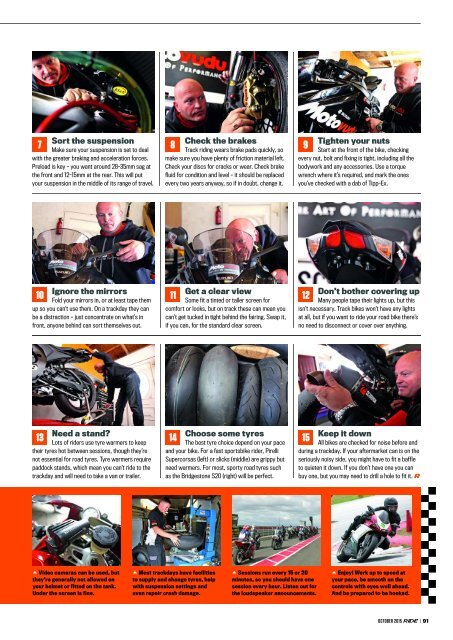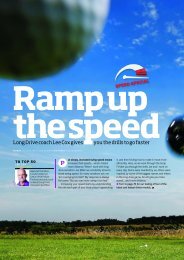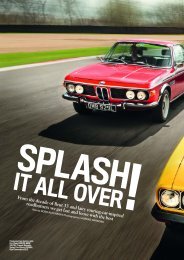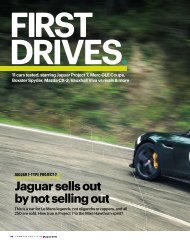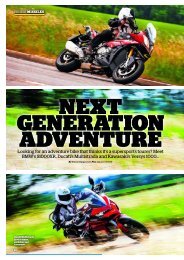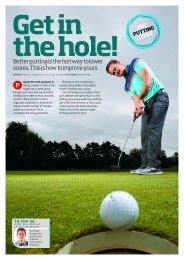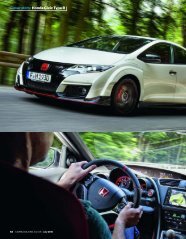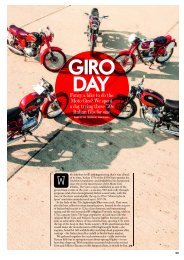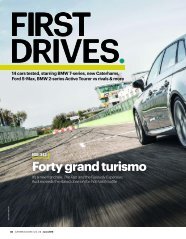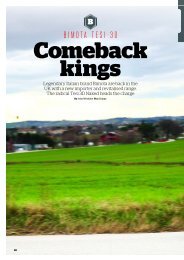Motorbikes.pdf
Create successful ePaper yourself
Turn your PDF publications into a flip-book with our unique Google optimized e-Paper software.
7<br />
Sort the suspension<br />
Make sure your suspension is set to deal<br />
with the greater braking and acceleration forces.<br />
Preload is key – you want around 28-35mm sag at<br />
the front and 12-15mm at the rear. This will put<br />
your suspension in the middle of its range of travel.<br />
8<br />
Check the brakes<br />
Track riding wears brake pads quickly, so<br />
make sure you have plenty of friction material left.<br />
Check your discs for cracks or wear. Check brake<br />
fluid for condition and level – it should be replaced<br />
every two years anyway, so if in doubt, change it.<br />
9<br />
Tighten your nuts<br />
Start at the front of the bike, checking<br />
every nut, bolt and fixing is tight, including all the<br />
bodywork and any accessories. Use a torque<br />
wrench where it’s required, and mark the ones<br />
you’ve checked with a dab of Tipp-Ex.<br />
10<br />
Ignore the mirrors<br />
Fold your mirrors in, or at least tape them<br />
up so you can’t use them. On a trackday they can<br />
be a distraction – just concentrate on what’s in<br />
front, anyone behind can sort themselves out.<br />
11<br />
Get a clear view<br />
Some fit a tinted or taller screen for<br />
comfort or looks, but on track these can mean you<br />
can’t get tucked in tight behind the fairing. Swap it,<br />
if you can, for the standard clear screen.<br />
12<br />
Don’t bother covering up<br />
Many people tape their lights up, but this<br />
isn’t necessary. Track bikes won’t have any lights<br />
at all, but if you want to ride your road bike there’s<br />
no need to disconnect or cover over anything.<br />
13<br />
Need a stand?<br />
Lots of riders use tyre warmers to keep<br />
their tyres hot between sessions, though they’re<br />
not essential for road tyres. Tyre warmers require<br />
paddock stands, which mean you can’t ride to the<br />
trackday and will need to take a van or trailer.<br />
14<br />
Choose some tyres<br />
The best tyre choice depend on your pace<br />
and your bike. For a fast sportsbike rider, Pirelli<br />
Supercorsas (left) or slicks (middle) are grippy but<br />
need warmers. For most, sporty road tyres such<br />
as the Bridgestone S20 (right) will be perfect.<br />
15<br />
Keep it down<br />
All bikes are checked for noise before and<br />
during a trackday. If your aftermarket can is on the<br />
seriously noisy side, you might have to fit a baffle<br />
to quieten it down. If you don’t have one you can<br />
buy one, but you may need to drill a hole to fit it.<br />
Video cameras can be used, but<br />
they’re generally not allowed on<br />
your helmet or fitted on the tank.<br />
Under the screen is fine.<br />
Most trackdays have facilities<br />
to supply and change tyres, help<br />
with suspension settings and<br />
even repair crash damage.<br />
Sessions run every 15 or 20<br />
minutes, so you should have one<br />
session every hour. Listen out for<br />
the loudspeaker announcements.<br />
Enjoy! Work up to speed at<br />
your pace, be smooth on the<br />
controls with eyes well ahead.<br />
And be prepared to be hooked.<br />
OCTOBER 2015 | 91


